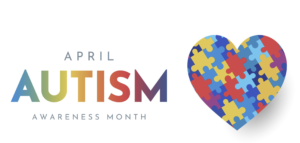
What is Autism?

What is Autism?
April is Autism Awareness Month. Autism is the fastest growing developmental disability in the WORLD! Autism is a lifelong neurological disorder affecting how an individual processes information, communicates and relates to the world around them. Each individual is unique and on a different continuum on the Autism spectrum. “If you’ve met one person with autism, you’ve met one person with autism.”
Some common behaviors associated with Autism are: repetitive movements, such as: flapping and clapping; and tantrums such as: crying, screaming, kicking, stomping. There are several challenges associated with Autism that impact social skills, emotions, speech, nonverbal communication, and sensory processing challenges, which directly correlates with food preferences as well.
Here are some mind-blowing statistics about Autism: In 1990, 30 out of 10,000 children were impacted by Autism. In 2000, 1 in 150 children were impacted by Autism. In 2010, 1 in 68 children were impacted by Autism. In 2021, 1 in 44 children were impacted by Autism. In 2023, 1 in 22 are impacted by Autism in California!! These statistics are alarming!! You may be asking yourself, why? What’s the cause? Why have the numbers so drastically increased over the decades? THE ANSWER IS…there’s not one concrete answer. There are several variables that have potentially impacted these numbers as they may be environmental and genetic.
What can be done about this phenomenon? Chances are, someone you know may be affected by Autism Spectrum Disorder, ASD. Early intervention is key for those on the spectrum and will drastically improve a child’s life and outcome. The brain grows the most rapidly from ages 0-5 years. The earlier a child receives help, the better the outcome will be. The connections in the brain are most adaptable in the first three years of life. These connections, also called neural circuits, are the foundation for learning, behavior, and health. After age 5, it is more difficult to change the brain. Therefore, it is important to advocate for the needs of the child as soon as possible and get the necessary help. Some various types of therapy that may be needed for the child include: speech therapy, occupational therapy, behavior therapy, floortime therapy and one-on-one support at school.
As Autism impacts the life of the child with ASD, it also impacts the lives of those around them. Parents often need additional support (both emotionally and physically). Parents will need to become advocates for their child and to get them the necessary tools to overcome presenting challenges. If the ASD child has siblings, their lives will automatically be impacted as well. The family will need support and resources from their community, family and friends to make it through. In some instances, it is not possible to receive additional support from family and friends. Which in turn, makes it imperative for parents and siblings with an ASD family member to find necessary support through therapy and other available resources.
As a licensed Marriage and Family Therapist, I specialize in working with families of children with special needs. I have seen parents and families benefit from couples’ therapy, individual therapy, family therapy and play therapy. Parents may also need to find someone to help guide them, showing them “the ropes” of advocacy for their child- in school systems and social situations. Building a supportive community and working with others that have traveled this difficult road will make the challenges ASD presents a bit more manageable. If you find yourself on this journey and have questions, please feel free to reach out. You are not traveling on this unknown journey alone. I am here to help guide and be a support for you.
